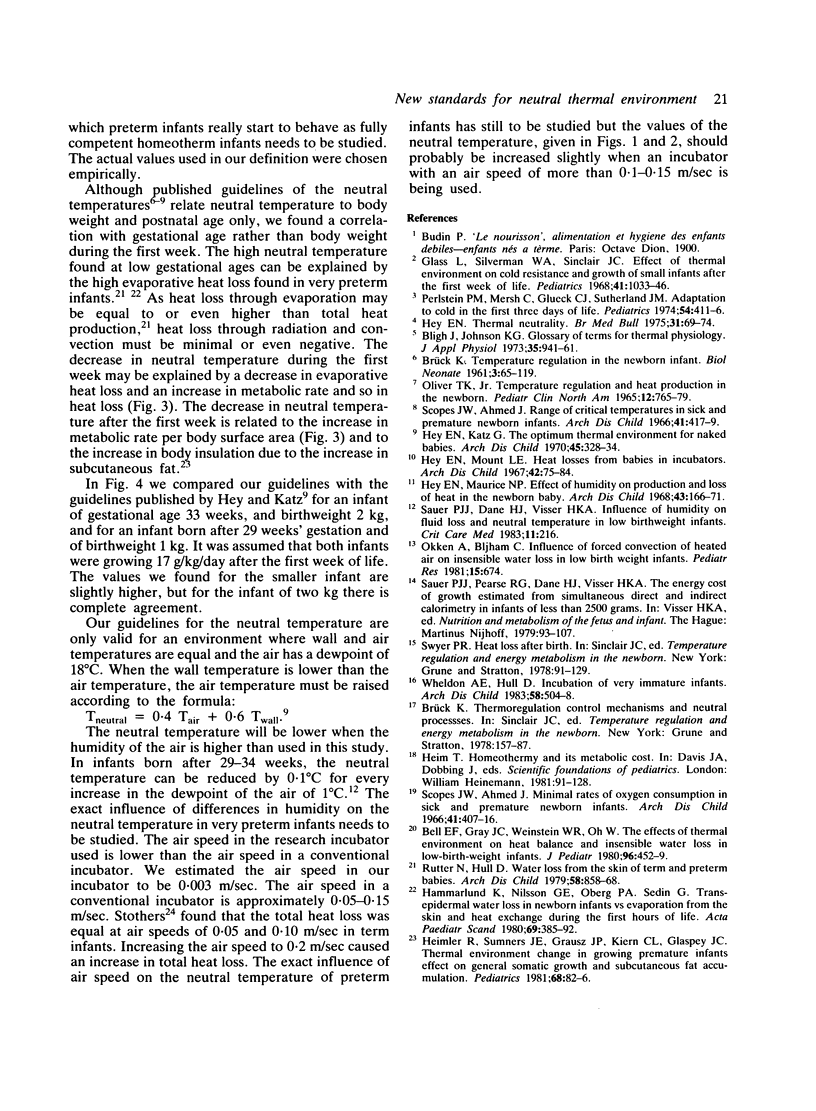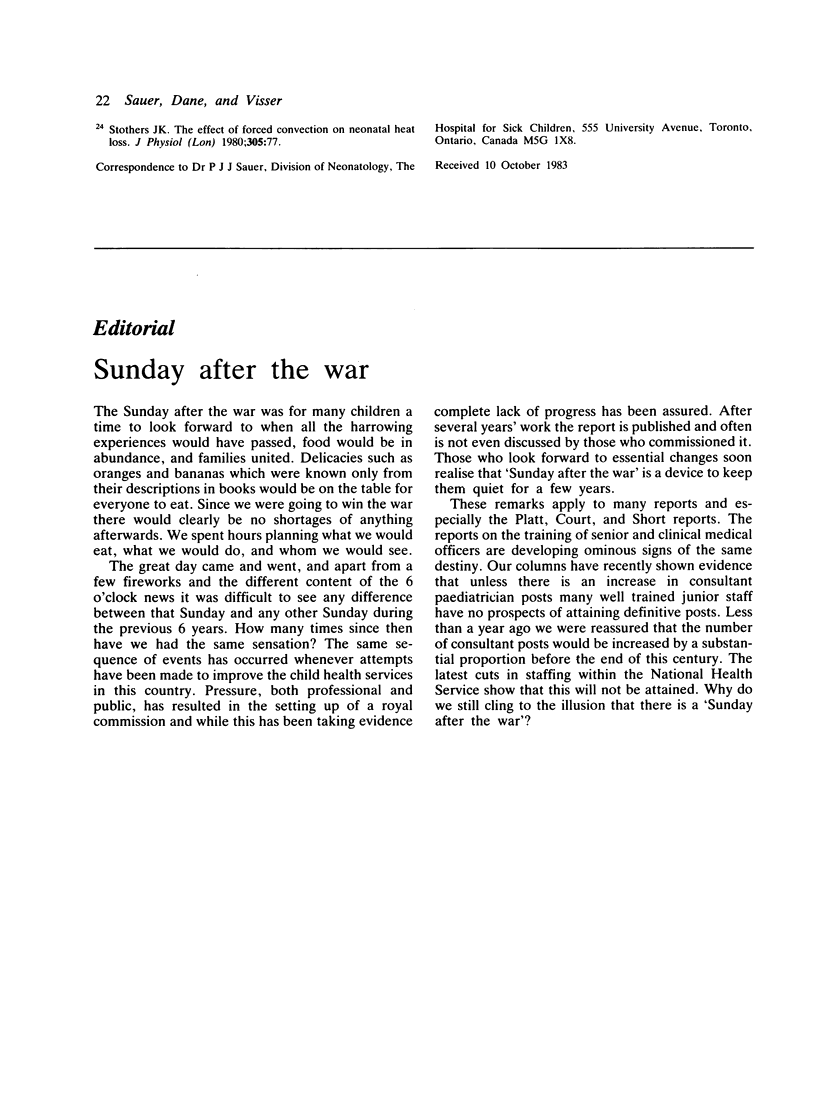Abstract
It is generally accepted that low birthweight infants should be nursed at thermal neutral temperature--the environment in which oxygen consumption is at a minimum. Low birthweight infants do not, however, always show an increase in oxygen consumption at a temperature outside the neutral range, but react with a change in body temperature. We redefined therefore the neutral temperature for these infants as 'the ambient temperature at which the core temperature of the infant at rest is between 36.7 and 37.3 degrees C and the core and mean skin temperatures are changing less than 0.2 and 0.3 degrees C/hour respectively'. Using this definition, new guidelines of the neutral temperature have been made for healthy infants of 29-34 weeks' gestation. The neutral temperature during the first week of life is dependent on gestational age and postnatal age, whereas after the first week it depends on body weight and postnatal age. Using this definition and the guidelines, the appropriate environmental temperature for the individual patient can be chosen.
Full text
PDF




Selected References
These references are in PubMed. This may not be the complete list of references from this article.
- Bell E. F., Gray J. C., Weinstein M. R., Oh W. The effects of thermal environment on heat balance and insensible water loss in low-birth-weight infants. J Pediatr. 1980 Mar;96(3 Pt 1):452–459. doi: 10.1016/s0022-3476(80)80697-4. [DOI] [PubMed] [Google Scholar]
- Bligh J., Johnson K. G. Glossary of terms for thermal physiology. J Appl Physiol. 1973 Dec;35(6):941–961. doi: 10.1152/jappl.1973.35.6.941. [DOI] [PubMed] [Google Scholar]
- Glass L., Silverman W. A., Sinclair J. C. Effect of the thermal environment on cold resistance and growth of small infants after the first week of life. Pediatrics. 1968 Jun;41(6):1033–1046. [PubMed] [Google Scholar]
- Hammarlund K., Nilsson G. E., Oberg P. A., Sedin G. Transepidermal water loss in newborn infants. V. Evaporation from the skin and heat exchange during the first hours of life. Acta Paediatr Scand. 1980 May;69(3):385–392. doi: 10.1111/j.1651-2227.1980.tb07097.x. [DOI] [PubMed] [Google Scholar]
- Heimler R., Sumners J. E., Grausz J. P., Kien C. L., Glaspey J. C. Thermal environment change in growing premature infants: effect on general somatic growth and subcutaneous fat accumulation. Pediatrics. 1981 Jul;68(1):82–86. [PubMed] [Google Scholar]
- Hey E. N., Katz G. The optimum thermal environment for naked babies. Arch Dis Child. 1970 Jun;45(241):328–334. doi: 10.1136/adc.45.241.328. [DOI] [PMC free article] [PubMed] [Google Scholar]
- Hey E. N., Maurice N. P. Effect of humidity on production and loss of heat in the newborn baby. Arch Dis Child. 1968 Apr;43(228):166–171. doi: 10.1136/adc.43.228.166. [DOI] [PMC free article] [PubMed] [Google Scholar]
- Hey E. N., Mount L. E. Heat losses from babies in incubators. Arch Dis Child. 1967 Feb;42(221):75–84. doi: 10.1136/adc.42.221.75. [DOI] [PMC free article] [PubMed] [Google Scholar]
- Hey E. Thermal neutrality. Br Med Bull. 1975 Jan;31(1):69–74. doi: 10.1093/oxfordjournals.bmb.a071244. [DOI] [PubMed] [Google Scholar]
- OLIVER T. K., Jr TEMPERATURE REGULATION AND HEAT PRODUCTION IN THE NEWBORN. Pediatr Clin North Am. 1965 Aug;12:765–779. doi: 10.1016/s0031-3955(16)31744-8. [DOI] [PubMed] [Google Scholar]
- Peristein P. H., Hersh C., Glueck C. J., Sutherland J. M. Adaptation to cold in the first three days of life. Pediatrics. 1974 Oct;54(4):411–416. [PubMed] [Google Scholar]
- Rutter N., Hull D. Water loss from the skin of term and preterm babies. Arch Dis Child. 1979 Nov;54(11):858–868. doi: 10.1136/adc.54.11.858. [DOI] [PMC free article] [PubMed] [Google Scholar]
- Wheldon A. E., Hull D. Incubation of very immature infants. Arch Dis Child. 1983 Jul;58(7):504–508. doi: 10.1136/adc.58.7.504. [DOI] [PMC free article] [PubMed] [Google Scholar]


